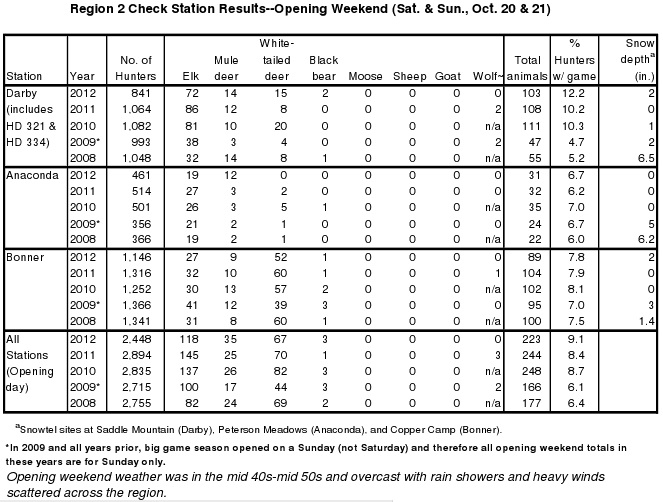The following report is an update from Fish, Wildlife and Parks Region 2 on Montana’s opening weekend of rifle season:
Harvest Good Despite Lower Hunter Numbers for West-Central Montana
Montana’s big game rifle season opened Saturday, and although slightly fewer hunters headed to the field in west-central Montana than in recent years, those that went out met with success rates above last year and the five-year average.“In many west-central Montana hunting districts, a general deer or elk license is only good for the harvest of an antlered animal, which is a shift from how things were five years ago,” says Mike Thompson, Montana Fish, and Wildlife & Parks (FWP) Region 2 Wildlife Manager. “With fewer opportunities for general license holders, we’ve got fewer hunters in some districts, but so far they are having decent success.”
Nine percent of hunters that travelled through one of the region’s three hunter check stations on opening weekend had harvested game, compared to a seven percent five-year average. Check stations tallied 2,448 hunters and a harvest of 118 elk, 35 mule deer, 67 white-tailed deer, and three black bears.
Mule deer harvest was up on opening weekend compared to last season and the five-year average, due mostly to an above-average harvest in the upper Clark Fork districts. White-tailed deer harvest was on par with the 2011 opener and 10 percent below the five-year average, while elk hunters reported a harvest 19 percent below last season but 10 percent above the five-year.
For the third year in a row, youth hunters, ages 12-15, had the chance to hit the field a few days earlier for a youth deer hunt that began on Oct. 18. Extra opportunity yielded extra success for some youth.
“It’s always fun to see kids come through with their first deer—some taken during Thursday or Friday of the youth-only deer hunting season, and some right alongside the grown-ups,” Thompson says.
Thompson spent opening weekend at the hunter check station near Darby where hunter numbers were 19% below the five-year average, as expected, Thompson says, due to the new requirement for hunters older than 15 years of age to hold a permit or special license to hunt elk in Hunting District 270—the East Fork of the Bitterroot.
“Bitterroot districts were slow, but hunters returning from Big Hole on Sunday bumped the elk harvest through Darby to a level 32% higher than the five-year average for opening weekend,” Thompson reports. “Elk harvest through Darby from the Big Hole normally drops off sharply after the first weekend.”
Hunter numbers through the Bonner hunter check station were lower than they have been for the start of the season since 2007, but hunters still checked 52 white-tailed deer, compared to 60 in the 2011 opener, and the age class of the deer was good news for biologists.
“We saw mostly young white-tailed bucks, which is a good thing because it tends to reflect better recent recruitment of young deer into a population and forecasts an overall boost in white-tailed deer numbers to come,” says Jay Kolbe, FWP wildlife biologist for the Blackfoot area.
Kolbe also reported checking a few nice older age-class bucks and reflected that elk harvest out of the Blackfoot districts was down a bit from recent years and dispersed.
Hunters that headed to the eastern part of the region near Deer Lodge and Anaconda, met with average success for elk where FWP biologist, Ray Vinkey, reported checking a few nice bulls through the Anaconda hunter check station.
“This year’s opener intersected with the tail end of the elk rut, and that combined with the cooler weather, helped out a few hunters,” Vinkey says. Hunter numbers at Anaconda were nine percent higher than the five-year average, but lower than the past two seasons.
From now until the November 25th season closing date, hunters will point toward the deer rut in early and mid-November, and hope for snow in the mountains before Thanksgiving to move elk out of the high country.
In Montana’s third wolf season, hunters have marked a statewide harvest of seven wolves since the rifle opener on Oct. 15. Three wolves came from FWP Region 2 in Granite, Powell and Missoula counties. Hunters harvested nine additional wolves during the early archery and backcountry rifle seasons, for a total statewide harvest to-date of 16 wolves.
Thompson cautioned that as all hunters get into their routines for the season, a few lessons learned on the opening weekend are important to keep in mind.
“Hunters should make double sure to fasten tags securely, and check them again as they load their animal for the trip home,” Thompson says. “And check the regulations to be sure you have a special “b” license, when needed, to hunt for antlerless deer or elk, as we’ve had quite a few regulation changes in the past few years.”
Safety precautions for hunting in bear country should also be on the top of hunters’ minds, Thompson cautioned. Bears are often out and active through the duration of big game rifle season.
Hunters are reminded that they must stop at all check stations that they pass on their way to or from hunting—even if they have not harvested any animals. The general rifle season for deer and elk runs through Sunday, Nov. 25.
